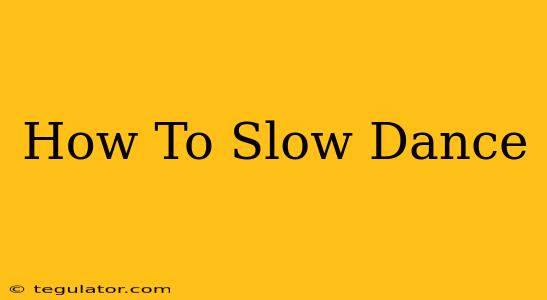So, you've got a slow dance coming up, and you're feeling a little...unprepared? Don't worry! Slow dancing might seem intimidating, but with a little practice and these helpful tips, you'll be gliding across the floor with confidence in no time. This guide will cover everything from basic posture and steps to advanced techniques and handling different scenarios.
Mastering the Basics: Posture and Frame
The foundation of a good slow dance is proper posture and a comfortable frame. This isn't about rigidity; it's about creating a sense of balance and elegance.
Finding Your Balance:
- Stand tall: Keep your back straight, shoulders relaxed, and chin up. Avoid slouching or hunching over. Imagine a string gently pulling you upward from the crown of your head.
- Engage your core: This provides stability and prevents you from swaying too much. Think about gently tightening your abdominal muscles.
- Relax your arms: Don't tense up! Your arms should be relaxed but not limp. A gentle, but not rigid, hold is key.
Establishing a Comfortable Frame (for the Lead):
- Open your chest: Maintain an open and inviting posture. Avoid hunching or closing off your body.
- Extend your arms: Extend your arms to your partner comfortably, creating a connection without being overly forceful.
- Use gentle guidance: Lead with confidence and subtlety, using your arms and slight movements to guide your partner through the dance.
The Follow's Role:
- Maintain good posture: Mirrors the lead's posture guidance for balance and elegance.
- Relax and respond: Allow your partner to lead while maintaining a relaxed posture and responding to their movements.
- Trust your partner: A successful slow dance requires trust and cooperation between the two dancers.
Slow Dance Steps: Simple and Effective
The beauty of slow dancing is its simplicity. You don't need fancy footwork; the focus is on connection and rhythm.
The Basic Step:
- Step-together-step: A simple step-together-step pattern for both partners works perfectly. Coordinate your steps with your partner, and try to match your rhythm.
- Gentle sway: Introduce a gentle sway in your body to maintain rhythm and add a touch of grace and fluidity.
- Vary the steps: Don't be afraid to try slight variations, like stepping slightly to the side or changing your footwork, but make sure to maintain connection.
Advanced Techniques: Adding Flair and Style
Once you master the basics, you can start to add your personal touch to your slow dance.
Adding the Spin (for experienced leads):
- Gentle guidance: Start with a small turn, and only if you are comfortable doing so. Always prioritize safety and comfort for your partner.
- Practice makes perfect: Practice with a trusted partner in a safe environment before attempting this in a public setting.
- Read your partner: Be sensitive to your partner's comfort level and stop if they feel uncomfortable or unsteady.
Dip (for very experienced couples):
- Trust is crucial: A dip requires significant trust, coordination and practice. It's not advisable for beginners.
- Controlled movement: The dip should be controlled and graceful, ensuring safety for both partners.
- Only attempt with a seasoned partner: It's essential to both practice and have confidence in your partner's skill level before even trying a dip.
Handling Different Scenarios
Slow dancing involves more than just steps; it's about interacting with your partner and adapting to different situations.
When to lead and when to follow:
- Communication is key: If you’re both unsure, communicate before starting. Determine who will lead and who will follow.
- Respect your partner: Adapt to your partner's style. If your partner prefers a slower, more gentle dance, adjust your movements to match their preference.
Dancing in crowded spaces:
- Maintain awareness: Be mindful of your surroundings and the people around you. Avoid stepping on others’ feet.
- Adjust movements: Keep movements smaller and more controlled to avoid collisions.
Practice Makes Perfect
The key to becoming a confident slow dancer is practice. Practice with a friend, family member, or partner to get comfortable with the steps and the rhythm. Remember to focus on connection, communication, and having fun! With a little effort, you'll be dancing the night away with grace and ease.

